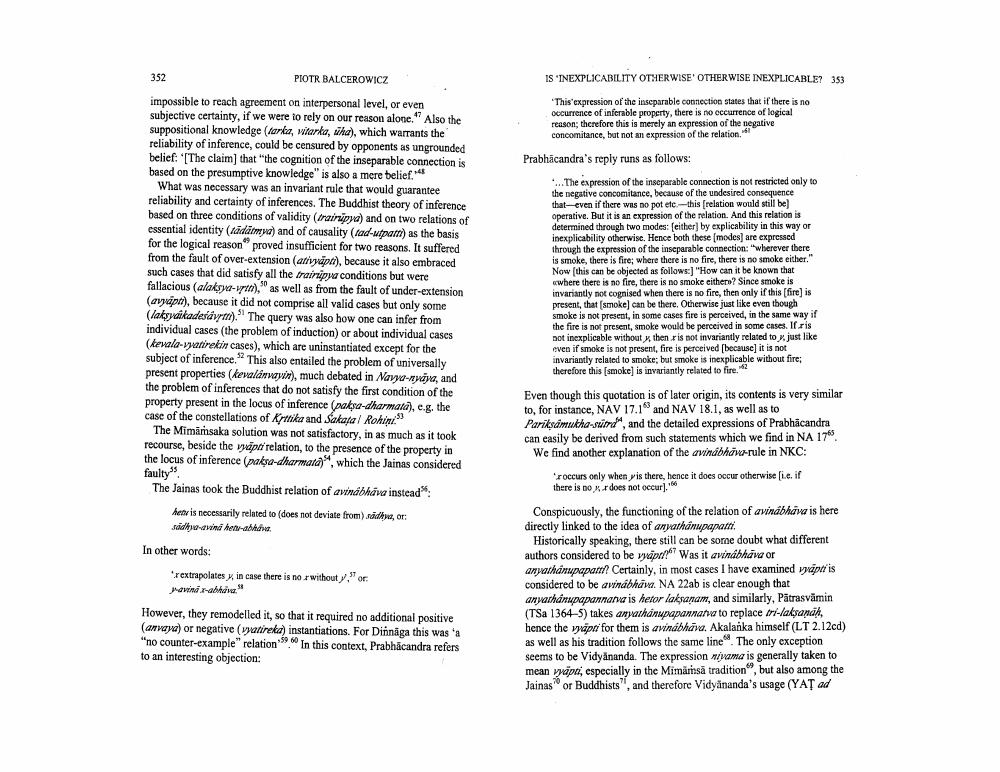________________
352
IS INEXPLICABILITY OTHERWISE' OTHERWISE INEXPLICABLE? 353
This'expression of the inseparable connection states that if there is no occurrence of inferable property, there is no eccurrence of logical reason; therefore this is merely an expression of the negative concomitance, but not an expression of the relation.**
Prabhācandra's reply runs as follows:
PIOTR BALCEROWICZ impossible to reach agreement on interpersonal level, or even subjective certainty, if we were to rely on our reason alone." Also the suppositional knowledge (tarka, wiarka, tha), which warrants the reliability of inference, could be censured by opponents as ungrounded belief: "[The claim that the cognition of the inseparable connection is based on the presumptive knowledge is also a mere belief.
What was necessary was an invariant rule that would guarantee reliability and certainty of inferences. The Buddhist theory of inference based on three conditions of validity (trairāpya) and on two relations of essential identity (ládamna) and of causality (tad-utpati) as the basis for the logical reason" proved insufficient for two reasons. It suffered from the fault of over-extension (ativapa), because it also embraced such cases that did satisfy all the trairip conditions but were fallacious (alakswa-w ), as well as from the fault of under-extension (av ), because it did not comprise all valid cases but only some (lakyaikadesát). The query was also how one can infer from individual cases the problem of induction) or about individual cases (kevala-watirekin cases), which are uninstantiated except for the subject of inference. This also entailed the problem of universally present properties (kevalánawin), much debated in Navya-waya, and the problem of inferences that do not satisfy the first condition of the property present in the locus of inference (paksa-dharmatd), e.g. the case of the constellations of Kritika and Sataja/ Rohin."
The Mimarisaka solution was not satisfactory, in as much as it took recourse, beside the vapoi relation, to the presence of the property in the locus of inference (paksa-dharmatd)", which the Jainas considered faulty
The Jainas took the Buddhist relation of awindibhava instead
... The expression of the inseparable connection is not restricted only to the negative concomitance, because of the undesired consequence that even if there was no pot etc.--this [relation would still be) operative. But it is an expression of the relation. And this relation is determined through two modes: (either by explicability in this way or inexplicability otherwise. Hence both these (modes are expressed through the expression of the inseparable connection wherever there is smoke, there is fire; where there is no fire, there is no smoke either." Now this can be objected as follows:) "How can it be known that owhere there is no fire, there is no smoke eithero? Since smoke is invariantly not cognised when there is no fire, then only if this (fire) is present, that (smoke) can be there. Otherwise just like even though smoke is not present, in some cases fire is perceived, in the same way if the fire is not present, smoke would be perceived in some cases. If ris not inexplicable without x, then r is not invariantly related to x, just like even if smoke is not present, fire is perceived (because it is not invariantly related to smoke; but smoke is inexplicable without fire; therefore this (smoke) is invariantly related to fire.
her is necessarily related to (does not deviate from).didna, or:
ரம makes abiar,
ப
Even though this quotation is of later origin, its contents is very similar to, for instance, NAV 17.1 and NAV 18.1, as well as to Pariksdmutha sind", and the detailed expressions of Prabhacandra can easily be derived from such statements which we find in NA 17" We find another explanation of the avinábhāwzrule in NKC:
roccurs only when yis there, hence it does occur otherwise [i.e. if
there is no x r does not occur). Conspicuously, the functioning of the relation of awindbhawa is here directly linked to the idea of anyathanupapalli.
Historically speaking, there still can be some doubt what different authors considered to be vapal? Was it awindbhawe or anyathanupapam Certainly, in most cases I have examined vyápolis considered to be awindbhawa. NA 22ab is clear enough that anwarhánupapannana is hetor laksanam, and similarly, Pätrasvämin (TSa 1364-5) takes anyarhanupapannana to replace tri-laksanah, hence the wapi for them is avinábhava. Akalanka himself (LT 2.12cd) as well as his tradition follows the same line. The only exception seems to be Vidyananda. The expression /wama is generally taken to mean yapa, especially in the Mimarisă tradition, but also among the Jainasor Buddhists', and therefore Vidyananda's usage (YAT ad
In other words:
rextrapolates in case there is no r without y Jawinirana
or:
However, they remodelled it, so that it required no additional positive (anwawa) or negative (ypatireta) instantiations. For Dinnaga this was a "no counter-example" relation . In this context, Prabhācandra refers to an interesting objection:




